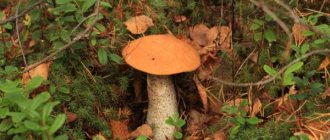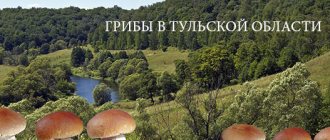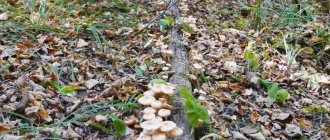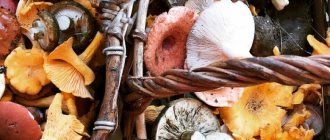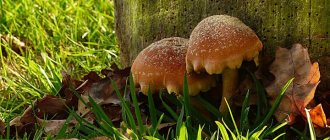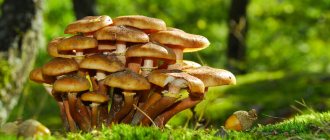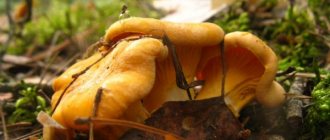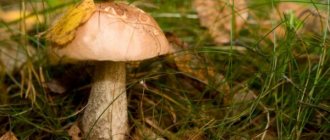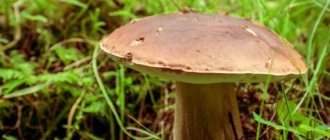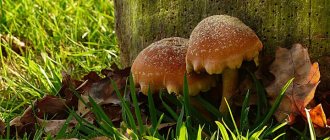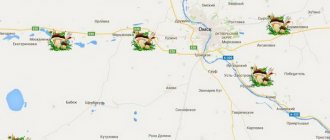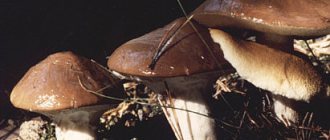Many different types of mushrooms are collected in the Tyumen region. Honey mushroom is rightfully considered one of the most delicious and healthy. There are about 30 species of honey mushrooms in Tyumen in 2021. Each individual species grows in its own time and in a certain area.
Before collecting honey mushrooms, you need to know exactly what they look like. Like all mushrooms, honey mushrooms have counterparts that are dangerous to health. Both species can easily grow in the same place. The most dangerous are sulfur-yellow and brick-red false moths. They are distinguished by their smell - edible honey mushrooms have a pleasant aroma, while poisonous ones smell like mold. The leg of a good honey mushroom is decorated with a filmy skirt, the plates are light, the cap is scaly and light in color. Poisonous honey mushrooms are without a skirt, smooth and more saturated colors.
If during a “quiet hunt” you find honey mushrooms that you are not sure about, it is better to refuse to collect them or consult with experienced mushroom pickers. In case of poisoning with poisonous honey mushrooms, if you feel weakness and convulsions, immediately call an ambulance.
Despite the fact that honey mushrooms contain many essential microelements, they should not be consumed if you have diseases of the stomach, pancreas, liver, or gall bladder.
After collecting honey mushrooms, they need to be processed immediately. Before cooking, they are boiled for about half an hour. Ready-made ones are used in many recipes. Mushrooms go well with meat and vegetables; they are stewed, fried, baked, or made into caviar. They are marinated for the winter, they become crispy and very tasty.
Mushroom places of the Tyumen region
There are several of the most mushroom places in the Tyumen region in 2022. The leaders are the Chervishevsky, Yalutorovsky and Old Tobolsky tracts. Experienced pickers also note fruitful clearings in the areas of Levasha, Krivodanovo, the villages of Lepki and Zhelezny Perebor.
Chervishevsky tract
Area of the Sibir sanatorium, 15 km from the city. Porcini mushrooms, aspen mushrooms, and boletuses grow here. It is better to come to these places for quiet hunting at the first rays of sun. Too many Tyumen residents come here to “hunt”.
Interesting read: Honey fungus: varieties and look-alikes.
Lefties
This place is located 30 km from the city. Mushrooms are found both to the left and to the right of the highway. Boletus, porcini mushrooms.
Yalutorovsky tract
Turn to Mullashi, 25 km from the city. Mushrooms are collected all along the road to the village. Porcini mushrooms, boletuses, saffron milk caps, volushki.
Old Tobolsk tract
The villages of Subbotino and Malkovo, 10 km from the city. On the left there is a river, on the right, behind the field, there is a forest. Porcini mushrooms grow on the hillocks. You're not lucky here often, though. By the way, there are a lot of forest roads here, where it’s easy to get lost or get stuck in your car.
Krivodanovo
At a distance of 25-30 km from the city, to the right of the highway behind the summer camps there is a dirt road. It is impossible to drive around the turn; the dirt road is well-travelled. The mushroom place is known to many, but the area where porcini mushrooms grow is also vast.
Iron Bust
40 km from the city. Turn after Bogandinskoye (small village). An asphalt road leads to Zhelezny Perebor. Further along the dirt road all the way to Novoatyalovo. Behind Iron Bus begins, perhaps, the most mushroom place in the vicinity of Tyumen. No matter how many mushroom pickers came here, everyone picked up several buckets, and exclusively porcini mushrooms. Milk mushrooms and even chanterelles grew here. Almost the entire mushroom assortment. However, much to the chagrin of avid mushroom pickers, forest fires raged here several years ago. Mushroom areas were burned out by 80 percent. There are mushrooms, and porcini mushrooms can be found, but not in such quantities as before.
Irbitsky tract
Kamenka, about 20 km from the city. Behind the village, to the left of the highway, there is a pine forest, where there are hillocks that are so loved by porcini mushrooms and lovers of quiet hunting. Just be careful: it's easy to get lost in these places. Some, they say, go astray and get off at Talitsa in the neighboring Sverdlovsk region.
Lepki village
90 km from the city (Sverdlovsk region). There are a lot of porcini mushrooms, because few Tyumen residents travel to those regions.
Salairsky tract
There are not many mushrooms on Verkhny Bor, probably because there are too many dacha cooperatives here. Mainly along this road, km 35, mushroom pickers go for honey mushrooms. The most mushroom places are in front of Salairka and near Narimanovo.
Velizhansky tract
Velizhany, 30 km from the city, - boletus, boletus. Turn to Verkhnyaya Tavda, approximately 90 km from the city, before reaching Uval. This is already the Sverdlovsk region. Along the road there is a birch grove. Amazingly beautiful forest. A typical landmark is cars parked along the highway. People come here for boletus mushrooms. And the long trip is worth it.
How not to get lost in the forest?
Getting lost in the forest is a piece of cake, and even experienced Tyumen mushroom pickers can sometimes get lost in three pines. To prevent the whole city from looking for you later, it’s worth remembering a few rules before heading into the forest.
1. Be sure to tell your family exactly where you will be picking mushrooms, so that it will be easier to find you if you get lost. It's better to wear something bright and catchy, because... in encephalitis and army “camouflage” you will simply blend in with the trees.
2. Take with you a compass, a mobile phone with a GPS navigator, a knife, matches, food and water, even if you plan to go on a “quiet hunt” for a short time.
3. Don’t be shy to shout “ay” if you have lost someone or feel lost yourself.
4. Don't take alcohol with you. One of the reasons for mushroom pickers wandering through the forest is the green snake.
[tds_info]
What mushrooms grow in the Tyumen region
People go to harvest forests at any time of the year if they know what the edible species look like, which allows them not to be confused with their poisonous or false counterparts.
Spring views
These mushrooms include:
- morels;
- lines;
- rows;
- double-ringed champignons;
- raincoats;
- entolomas.
Under certain conditions, strings and morels can accumulate poisons, so they are thoroughly boiled or dried before use.
Summer views
With the onset of summer, mushroom pickers collect in the forests of the region:
- White mushrooms;
- boletus;
- boletus;
- boletus;
- Russula;
- honey mushrooms;
- spikelets;
- chanterelles, etc.
Russulas are collected en masse at this time of year. They love to grow in birch groves.
Autumn types of mushrooms
Summer species have not yet disappeared, but autumn species are already appearing. The most commonly collected species during this period are:
- Russula;
- honey mushrooms;
- white;
- boletus;
- saffron milk caps;
- chanterelles, etc.
The end of August and the beginning of autumn is the most favorable period for harvesting.
Interesting read: Boletus mushroom: what types of mushrooms are boletus mushrooms.
general characteristics
A good assistant when harvesting a forest harvest is a mushroom calendar, which tells you which mushrooms are best to look for in spring, summer or autumn.
Before collecting, you should decide what the products will be used for; you need to know their main characteristics. Mushrooms have different tastes and degrees of edibility. Some are better cooked, while others will be much tastier when salted or pickled.
According to their edibility characteristics, all mushrooms are divided into several categories:
- Category 1: edible;
- Category 2: conditionally edible;
- Category 3: inedible;
- Category 4: poisonous.
They, in turn, are divided into groups according to taste characteristics:
- the most fragrant: all types of whites, boletus;
- less aromatic: chanterelles, butterfly mushrooms, etc.;
- with a weak aroma and taste: moss mushrooms, milkweed, etc.
The latter have a pungent taste and unpleasant aroma. They are difficult to process and require long soaking and pre-cooking. In Tyumen they are not touched, because there are a lot of other good mushrooms that can be collected with fewer pre-processing problems.
Before use, mushrooms are carefully sorted, washed and cleaned. Milkworms have their own characteristics, so it is better to collect them if you have a proven cooking recipe.
You should not collect poisonous mushrooms: fly agarics, toadstool, etc.
The most mushroom places in Tyumen
Not far from the city (about 25 km), if you follow the old Tobolsk highway, you can get to the village of Krivodanovo. You should turn onto the dirt road that runs behind the summer camps to see the vast area. And if you drive beyond the Tobolsk highway to the village of Bogandinsky (approximately 40 km from Tyumen), you can pick up porcini mushrooms and boletus mushrooms.
Experienced mushroom pickers know that porcini mushrooms most often grow in pine forests. If you follow the road to the village of Kamenka, which is located 35 km from the city, you can pick up a lot of porcini mushrooms. Porcini and boletus mushrooms are also found near the village of Yagodnoye.
15 km from Tyumen there is the Sibir sanatorium, near which boletuses, milk mushrooms, russula and trumpet mushrooms grow. You can get to the sanatorium by car or public transport:
- Bus 1, 3 depart from the railway station (stop “Central Market”);
- from Roshchino airport by bus 10, 141. Get off at the Central Market stop.
The village of Mullashi, which is located near the tributaries of the Duvan and Pyshma rivers (the distance from Tyumen is about 25 km), is also considered a favorite place among mushroom pickers. This area is rich in porcini mushrooms, saffron milk caps and red mushrooms.
Not far from the village of Oshchepkovo (90 km along the Moscow Highway) you can find porcini mushrooms, boletus and russula. Closer to autumn, you can also collect honey mushrooms here. There are also many mushroom places along the Moscow Highway in the area of the village of Uspenka. Russula, boletus and boletus are found here.
Those who love milk mushrooms are advised to go to the village of Kommunar, which is on the 60th kilometer of the Chervishevsky tract and near the village of Kamenka. Mushrooms can also be found here this year. Tyumen residents also collect milk mushrooms in the Isetsky region.
What can edible mushrooms be confused with?
In the Tyumen forests, mushroom pickers warn, you can most often run into toadstools, fly agarics and gall mushrooms. The most insidious is the gall mushroom; it can easily be confused with boletus or boletus. Not everyone knows how to distinguish a false porcini mushroom from a real one, although in reality it is not so difficult to do. The boletus has a darker cap, its bottom is white, yellow or greenish (the bitterling has a pink tubular layer), the mesh pattern of the leg is light (the bitterling is dark), and the flesh does not change its color. The differences from white mushrooms are more obvious; the main thing is to be careful when collecting wild mushrooms. Another popular name is false boletus. It can be confused with boletus by the color of its cap and scaly stem. The common boletus has a mushroom smell and does not turn pink when cut. False white is always very beautiful in appearance; because of its bitterness, animals, worms and insects do not eat it.
Other mushrooms also have similar counterparts. For example, edible honey mushrooms, which come closer to autumn, can easily be confused with false sulfur honey fungus. They also grow in bunches. The main difference is that edible honey mushrooms have a white film on the stem.
Every year, up to 40 cases of mushroom poisoning are registered in our region. The inability to distinguish an edible specimen from a poisonous one is one of the reasons why city residents end up in hospital beds. This year, five people turned to doctors: three cases were registered in Tyumen and two in Yalutorovsk.
How to pick mushrooms correctly
It is believed that in sunny weather you should go for mushrooms as early as possible: the slanting rays of the sun will interfere with the picking process. In addition, mushrooms that are not heated in the sun can be stored longer. You should not collect mushrooms in the first bucket or bag you come across: forest fruits in an airtight container can spoil, especially during long-term transportation. It is also not recommended to put loot in a backpack - they may crumble. The best choice is a wicker basket.
There is a lot of debate about how to properly pick mushrooms in the forest. Mycologists say that there is no clear answer to this question, and one should proceed from the type of mushroom. Prey brought home cannot be stored for a long time. And it's better not to leave it overnight. During this time, microorganisms will develop in the mushrooms, which will not only visually spoil the mushroom, but can also cause serious poisoning. Therefore, they need to be processed in a timely manner.
Inedible and poisonous mushrooms
Poisonous mushrooms are deadly
In the forests of Tyumen there are poisonous and inedible species:
- fly agarics;
- toadstools;
- stropharia;
- cobweb;
- gall;
- talker.
Stropharia hemispherical has a slightly strange appearance and is not familiar to everyone. Considered a hallucinogenic species, it grows in moist soils and is sometimes found on manure heaps.
Irina Selyutina (Biologist):
Stropharia hemisphericus belongs to the genus Stropharia of the same name and the family Strophariaceae. The mushroom got its name from the shape of its cap, which never opens. They are found from mid-summer almost until late autumn on manured soil or even just on manure. Stropharia is characterized by the presence of psilocycin in its pulp, which allows it to be classified as a group of hallucinogenic mushrooms. Despite the fact that the psilocycin activity of the mushroom is insignificant, and sometimes it is absent, the mushroom cannot be considered safe, because Psilobicin causes psychological dependence.
The reddened fly agaric is distinguished by a colorful cap on which there are white spots. Sometimes this species reaches large sizes. The mushroom is not eaten because of the poison.
The most poisonous is the toadstool. Many people die from its toxins. Outwardly, it looks like a honey fungus, the only difference is the skirt with a leg. When harvesting, you need to carefully inspect all specimens, because a single toadstool that ends up in a basket can ruin the entire harvest.
A lover of quiet hunting told Tyumen residents how and where to look for mushrooms
An experienced collector told Tyumen residents about where and how to look for mushrooms: the expert explained how porcini mushrooms differ in pine and deciduous forests, Vsluh.ru reports.
Tyumen mushroom pickers have already begun to collect the first “harvests”. Very soon the forests of the region will become rich in mushrooms. Vitaly Lazarev , a mushroom picker, hunter and nature lover, shared his knowledge about the best places and when to look for them.
Mushrooms mainly grow in hilly pine forests; there are many such areas in the Tyumen region. In the last days of May, the first mushrooms appear. However, weather conditions are an important factor. With 100% probability, their appearance will be ensured by two weeks of rain followed by warm weather. Morels, strings and boletus grow earlier in the region than others.
Porcini mushrooms are considered the best that are found in the Tyumen region. They can be found in pine and deciduous forest areas. In deciduous forests, porcini mushrooms are distinguished by caps with a shade of red and long stems, where they grow in lowlands. In pine forests, porcini mushrooms have brown caps, they look small in size, and they are mainly found in hilly areas. Near them you can find rednecks, saffron milk caps and boletus.
The expert also spoke about several secrets of experienced collectors. So, you can find a mushroom spot by looking at the white forest moss: there are usually a lot of mushrooms next to it. But porcini mushrooms appear next to fly agarics, the expert shares. Experienced mushroom pickers return to their previous mushroom places, usually the mushrooms grow again overnight.
Ryzhik
This mushroom is rightfully classified in the first category. The cap of the saffron milk cap is reddish-red on top with a funnel-shaped depression in the center. The lower part of the cap seems to be made of orange plates. The leg is short, also orange, hollow, and looks like a ring when cut. At the break of the mushroom, orange-red juice immediately releases. You touch the orange plates, give them a little squeeze, and they immediately turn green. Rizhik, unlike other mushrooms, is incomparably fragrant.
And it did well in terms of calorie content. If we talk about the calorie content in 100 g of product, then salted saffron milk caps are superior to pickled porcini mushrooms by 67 calories, dried boletus mushrooms by 8 calories, and chicken meat by 75.7 calories. The French used to be sent bottles of salted saffron milk caps from the Urals from Russia. In Paris they were valued more than champagne. They are such saffron milk caps.
Skripun
Or a violin . This mushroom got its name from the very squeaking noise that occurs when you rub the cap against the cap of freshly picked mushrooms. Few hunters take them into the basket; they do not want to interfere with other mushrooms. But in vain. This mushroom is not at all as bad as they think it is. The creaking goes mainly to salting. First, the mushroom must be thoroughly boiled in two waters.
Well, recognizing a violin among its relatives is as easy as shelling pears: break off a piece of the cap and immediately milky juice, white as milk, will appear in large drops. If you touch it lightly with the tip of your tongue, it will burn with bitterness.
Gruzd
There are parchment mushrooms, yellow and black, but this one is dry. The cap is funnel-shaped on top, while the cap of the young mushroom is flat. The plates under the cap are frequent, the stem is dense, the same color as the cap; the pulp is brittle. Dry milk mushrooms have long been valued in Russian cuisine for their taste and aroma. One of the most popular edible mushrooms in Siberia, the Urals and the East European Plain. Next to the dry milk mushrooms lives a yellow spruce mushroom with a fringe on the cap. He, like his brother, loves the silence of the forest, so he tries to hide under the spruce and fir paws.
